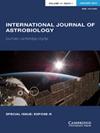围绕喷出的自由漂浮行星运行的外卫星演化过程中液态水的存在
IF 1
4区 物理与天体物理
Q3 ASTRONOMY & ASTROPHYSICS
引用次数: 2
摘要
自由漂浮行星(FFP)可能是行星系统生命最初几百万年发生的动力学散射过程的结果。一些模型预测了这些孤立的行星质量物体在弹射后保留外卫星的可能性。潮汐加热机制和具有相对高光学厚度的大气层的存在可以支持在这些卫星表面形成和维持液态水海洋。为了研究液态水可以维持的时间尺度,我们对喷射过程进行了动力学模拟,并推断出FFP周围幸存外卫星数量的统计结果。随后卫星轨道参数的潮汐演变是确定轨道何时圆形的关键步骤,潮汐加热会随之衰减。我们发现,大气层以二氧化碳为主的近地球质量卫星($a\lesssim 25$RJ)可以在长时间内将液态水保留在其表面,这取决于大气包层的质量和假设的表面压力。需要大质量的大气层来捕获潮汐摩擦产生的热量,使这些卫星适合居住。对于类似地球的压力条件(p0=1巴),卫星可以在其表面维持高达52Myr的液态水。对于更高的表面压力(10和100巴),卫星的宜居性可能分别高达276 Myr和1.6 Gyr。近距离卫星经历了长时间的宜居条件,在FFP弹出期间,它与逃逸的行星保持联系,受近距离相遇的影响较小。本文章由计算机程序翻译,如有差异,请以英文原文为准。
Presence of liquid water during the evolution of exomoons orbiting ejected free-floating planets
Free-floating planets (FFPs) can result from dynamical scattering processes happening in the first few million years of a planetary system's life. Several models predict the possibility, for these isolated planetary-mass objects, to retain exomoons after their ejection. The tidal heating mechanism and the presence of an atmosphere with a relatively high optical thickness may support the formation and maintenance of oceans of liquid water on the surface of these satellites. In order to study the timescales over which liquid water can be maintained, we perform dynamical simulations of the ejection process and infer the resulting statistics of the population of surviving exomoons around FFPs. The subsequent tidal evolution of the moons’ orbital parameters is a pivotal step to determine when the orbits will circularize, with a consequential decay of the tidal heating. We find that close-in (
$a \lesssim 25$
RJ) Earth-mass moons with carbon dioxide-dominated atmospheres could retain liquid water on their surfaces for long timescales, depending on the mass of the atmospheric envelope and the surface pressure assumed. Massive atmospheres are needed to trap the heat produced by tidal friction that makes these moons habitable. For Earth-like pressure conditions (p0 = 1 bar), satellites could sustain liquid water on their surfaces up to 52 Myr. For higher surface pressures (10 and 100 bar), moons could be habitable up to 276 Myr and 1.6 Gyr, respectively. Close-in satellites experience habitable conditions for long timescales, and during the ejection of the FFP remain bound with the escaping planet, being less affected by the close encounter.
求助全文
通过发布文献求助,成功后即可免费获取论文全文。
去求助
来源期刊

International Journal of Astrobiology
地学天文-地球科学综合
CiteScore
3.70
自引率
11.80%
发文量
45
审稿时长
>12 weeks
期刊介绍:
International Journal of Astrobiology is the peer-reviewed forum for practitioners in this exciting interdisciplinary field. Coverage includes cosmic prebiotic chemistry, planetary evolution, the search for planetary systems and habitable zones, extremophile biology and experimental simulation of extraterrestrial environments, Mars as an abode of life, life detection in our solar system and beyond, the search for extraterrestrial intelligence, the history of the science of astrobiology, as well as societal and educational aspects of astrobiology. Occasionally an issue of the journal is devoted to the keynote plenary research papers from an international meeting. A notable feature of the journal is the global distribution of its authors.
 求助内容:
求助内容: 应助结果提醒方式:
应助结果提醒方式:


